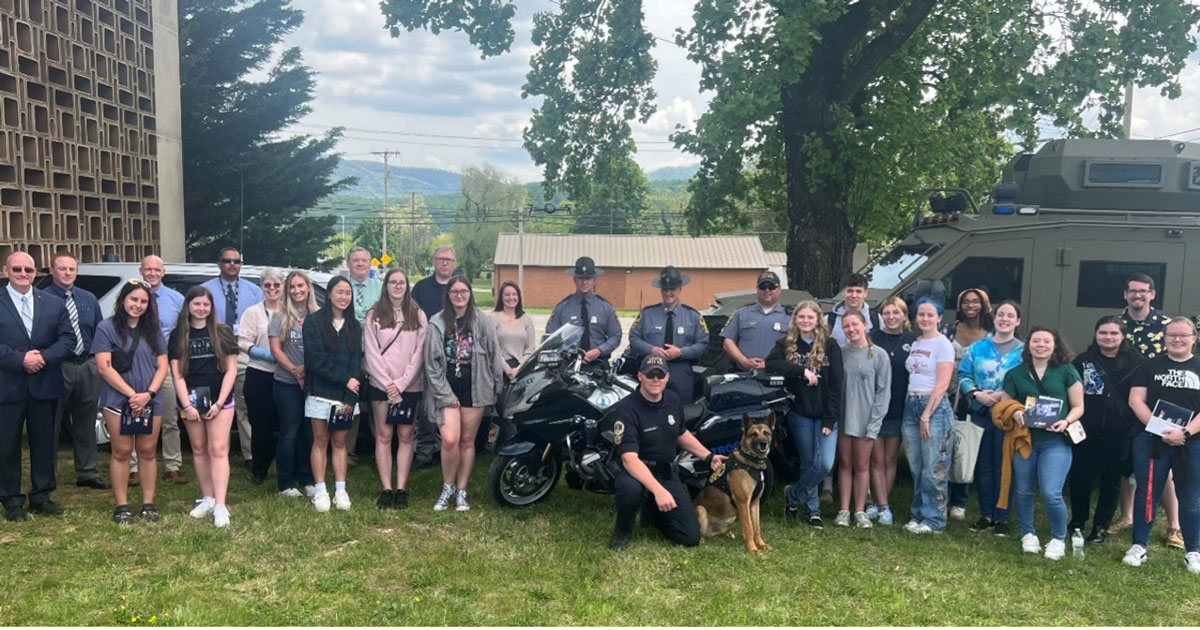
Criminal justice students visit state police headquarters
For 16 criminal justice students, a day at the Virginia State Police Division 6 Headquarters was more than just a visit; it was an eye-opening dive into the multifaceted world of modern law enforcement.
Organized by Assistant Professor Stacey Clifton, the April 24 field trip expanded upon last year’s program by showcasing an even broader spectrum of state police specialties.
“Students were able to see firsthand many aspects of the department such as how DNA is tested, how ballistics are analyzed, how dispatch handles emergency calls, how robots are used for the arson/bomb team, how drones are used for the tactical team, how polygraphs are conducted, how K-9s assist law enforcement, how criminal intelligence is gathered and disseminated and so much more,” Clifton said.
Having previously expressed interest in state police intelligence analysis, students followed up with a session on the division’s homeland security/intelligence division, which supports federal, state and local law enforcement in investigating criminal and terrorism-related activity.
Clifton called the field trip “a rare opportunity to experience the multitude of positions and specialties within the state police” beyond the classroom setting, adding, “I appreciate the time and effort the Virginia State Police put forth to give our students this unique experience.”
It’s summertime, and SURF’s up!
Undergraduate researchers at Radford have a busy summer ahead of them. These 20 projects are being funded through the Office of Undergraduate Research’s Summer Undergraduate Research Fellowships (SURF), which encourage students to make original, intellectual or creative contributions to a discipline. Each SURF provides $6,000 to the student (half at the beginning of June and the second half at the beginning of August), $1,500 for the faculty mentor (paid at the beginning of August), and supplies.
- Kiara Bartoli – reconstructing rainy season precipitation variability in sub-Saharan Africa across a network of annual tree-ring chronologies. Mentor: Stockton Maxwell
- Leah Bratton – connecting her personal experience with piano-playing-related injuries to the art of creating a one-handed composition like pianists of the past. Mentor: Matthew Cataldi
- Aerowen Bryant – using a scientific approach to create anthropomorphic ecological dystopian literature. Mentors: Sarah Foltz and Justine Jackson-Stone
- Morgan Buskill, Fiona Steinour and Amelia Naegele – exploring protoporphyrin IX’s potential solar energy conversion and medical applications by investigating its electronic properties, reactivity, and energy transfer capabilities. Mentor: Tim Fuhrer
- Joshua Czorapinski – designing, creating and testing protein variants and how changes affect the function of the protein. Mentor: Kim Lane
- Timothy Damankah – documenting and analyzing wild bee community assemblages and plant-pollinator networks within Selu Conservancy to provide valuable baseline data for future studies. Mentor: Chet Bhatta
- Victoria Dean – investigating and producing 3D images of the karst, hydrogeological and archeological features of the NRV Commerce Park in Pulaski, Virginia. Mentor: Hannah Krueger
- Krystal Drummond – examining the perceived cognitive effort of compassion and empathy in real-world social interactions and investigating their relationship to helping behaviors. Mentor: Daniel Berry
- Caleb Frankenberger – developing a software package for Bayesian regression models on pooled testing data. Mentor: Shakim Sarker
- Jeremiah Garretson – exploring the correlation between risk acceptance and personal locator beacons in the backcountry to influence recreation and rescue best practices. Mentor: Joshua Roe
- Amber Gordon – examining how the size of habitats influences mixed-species associations between squirrel monkeys and capuchins in a Costa Rican rainforest to inform conservation strategies. Mentor: Cassady Urista
- Sydney Howell-Wampler – studying the oppression that women face in Afghanistan under the rule of the Taliban and solutions by examining their escape strategies and possible countries for asylum. Mentor: Tay Tan
- Julia Miller – examining how approved memory training interventions, such as Spaced-Retrieval Training (SRT), impact indicators of stress among adults with moderate to advanced dementia. Mentors: Janessa Steele and Michaela Clark
- Grace Parton – exploring hormonal stress responses in crayfish to understand their role in stress reactivity under varying environmental conditions. Mentor: Jason Davis
- Bhavna Sheth – systematically reviewing the integration of artificial intelligence in early-onset dementia care and exploring its potential to enhance diagnosis, treatment and patient quality of life. Mentor: Pamela Frasier
- Emma Stipes – investigating the seismic structure of the Cascadia subduction zone on the West coast of the United States to better understand its mechanics and predict potentially dangerous tremors produced by it. Mentor: Hannah Krueger
- Ryan Stuck – developing an application that receives course content and utilizes AI to answer questions based on the course information. Mentor: Nathaniel Lahn
- Erin Torres – analyzing Azerbaijan's use of social media to influence international narratives, aiming to uncover state-sponsored propaganda tactics and their global impact. Mentor: Paige Tan
- Grace Wilson – examining how cemeteries as urban greenspaces impact passerine bird stress physiology, comparing urban and rural sites to assess avian adaptation to urbanization. Mentors: Jason Davis and Sarah Foltz
- Meagan Yates – exploring the biodistribution of microplastics when ingested by salamanders and the effect on their physiology. Mentor: Sara O’Brien